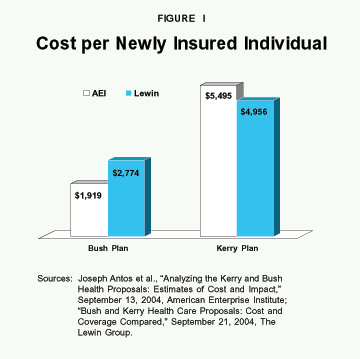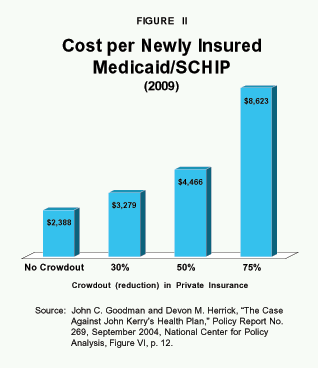Sen. John Kerry has proposed a plan to radically transform the U.S. health care system. The plan has one overriding goal: to reduce the number of the uninsured. Yet roughly two-thirds of the spending under the plan is devoted to subsidizing the cost of health insurance for those who already have coverage. As a result, the plan is very expensive in terms of what it attempts to achieve.

The Plan. The Kerry plan would build on existing federal programs. First, the federal government would pay the full cost of 20 million children in Medicaid, in exchange for states expanding coverage under Medicaid and the State Children's Health Insurance Program (SCHIP) – including uninsured children in families with incomes up to $56,550 for a family of four. Second, the Kerry plan would have the federal government "rebate" three-fourths of employers' catastrophic health claims costs (above about $30,000 per employee) if employers offer insurance to all employees and pay one-half the premium costs. Third, Kerry would create the Congressional Health Plan, similar to the federal employees insurance program, and offer numerous subsidies to individuals and small businesses to join this federally regulated health system.
How Much Will It Cost? Emory University Professor Kenneth Thorpe, who helped construct the Kerry plan, estimates it will cost $653 billion over nine years and insure 27 million additional individuals. If Thorpe's estimate is extended for 10 full years of operation and if questionable, or unrelated, savings are ignored, the number exceeds $1 trillion – an amount equal to almost $1,000 per year for every household in America. The Lewin Group, a respected health care consulting firm, estimates the cost at $1.25 trillion and places the number of newly insured at 25.2 million. An estimate by former government health officials and actuaries for the American Enterprise Institute put the 10 year cost at $1.5 trillion and the number of newly insured at 27.3 million.
Cost per Newly Insured. The Kerry plan provides numerous subsidy programs for various groups. Based on Thorpe's estimates, the annual cost to insure one new person varies from $2,217 for subsidies to the near-elderly (ages 55 to 64) to $14,190 to subsidize employers' catastrophic health care expenses. He estimates the average cost per newly insured at $2,445. Independent estimates put the cost much higher.
- According to the Lewin Group estimate, the cost per newly insured, on the average, would be $4,956 under the Kerry plan.
- The American Enterprise Institute estimate put the cost per newly insured at $5,495. [See Figure I.]
As a result, the cost of insuring a family of four under the Kerry plan would be about $20,000 or higher. Clearly it would be much cheaper to give them free health care.

Crowd Out. All these estimates assume that Kerry's insurance goals are largely achieved. But this conclusion is far too optimistic. The expansion of federal health programs will almost certainly crowd out private coverage. That is, employees will drop out of employer plans in order to enroll in public programs. And companies that employ large numbers of newly-Medicaid-eligible employees will tend to drop their health plans altogether.
Thorpe assumes that for every 10 new Medicaid enrollees under the Kerry plan, three people will lose private coverage. Thus to insure 18 million net new people through Medicaid expansion (the Kerry goal) he must enroll about 26 million additional people in Medicaid. Thorpe's assumption is probably too conservative. Actual crowd out could be as high as one for one. During the 1990s, for example, when taxpayers funded a large expansion of Medicaid and SCHIP, the fraction of the population that was uninsured actually rose.
A study by Harvard University Professor David Cutler and Massachusetts Institute of Technology Professor Jonathan Gruber found that the Medicaid expansions were substantially offset by reductions in private coverage. They found that, for every additional dollar spent on Medicaid, private sector health care spending was reduced by 50 to 75 cents on the average. Thus, as government insurance grew, private insurance contracted – leaving the numbers of uninsured virtually unchanged. More recent data suggests that the trade-off could be closer to one-to-one. That is, for each person who joins Medicaid, one person loses private coverage.
As a result, expanding Medicaid is a very inefficient way of insuring the uninsured. As Figure II shows:
- If Medicaid expansion induces a 30 percent contraction of private insurance (as Kerry assumes), the cost of insuring each new person, on net, will increase by more than one-third.
- At a more realistic 50 percent crowd-out rate, the cost almost doubles -reaching $4,466 per newly insured person or $17,864 for a family of four.
- At a 75 percent crowd-out rate, the cost of each newly insured person reaches $8,623, or $34,492 for a family of four.
A More Efficient Approach. The projections that Kerry's plan would extend coverage to 95 percent of the population are too high. By contrast, estimates that six to seven million would gain coverage under President Bush more targeted plan are probably too low. To reduce the number of uninsured, Bush proposes to encourage Health Savings Accounts (HSAs) in five ways: make individually-paid premiums for HSA plans tax deductible; make deposits to HSAs tax deductible; create a refundable tax credit for low-income health insurance purchases; allow up to one-third of the low-income tax credit to be used for HSA deposits; and establish a tax credit for small businesses that contribute to employees' HSAs.
Recent experience has proven that HSAs and similar health plans attract the uninsured. Assurant Health (formerly Fortis), one of the largest carriers operating in the individual and small group markets, has been selling HSA policies since January 2004. They report that some 43 percent of HSA buyers in the first few months indicated no prior health coverage. Earlier Internal Revenue Service data, from the medical savings accounts (MSAs) pilot project, indicate that in 2001 as many as 73 percent of new MSA holders were previously uninsured.
HSAs are efficient because they encourage individuals to be better health care consumers. HSAs reward people who avoid wasteful spending by allowing them to accumulate unspent HSA funds in interest-bearing accounts. For those with chronic conditions, HSAs provide a source of funds for expenses they would otherwise pay out of pocket.
Conclusion. Based on Kerry's (Thorpe's) own estimate, the Kerry proposal costs twice as much as President Bush's per newly insured. Under more realistic assumptions, Kerry's plan may cost four, five or six times more than Bush's plan.
John C. Goodman is president of the National Center for Policy Analysis.